It is a confession I am not at all ashamed to make: ElizabethOnFood and I are great fans of the wines of Camel Valley Vineyards in Nanstallon in Cornwall. To our minds, nothing beats a Camel Valley Bacchus Dry with some shellfish on a warm summer's day and when we serve the Pinot Noir Rosé Brut to guests at home blind, they are invariably as impressed with its quality as they are incredulous of its origin: Cornwall!
We had visited the winery before and had bought lots of bottles there, but when we were on holiday in Cornwall recently the opportunity presented itself to participate in the Grand Tour and Tasting (nice to see so many young people taking an interest in wine, by the way!) and to have a chat with Annie and Bob Lindo afterwards over a bottle of White Pinot Noir Brut 2006.
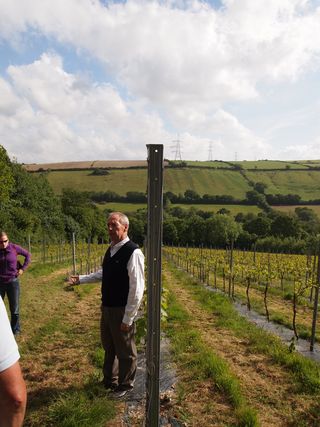
The history of Camel Valley Vineyards is quite well known and impressive though it is, I will not render it here. Much more interesting is the philosophy behind this hugely successful winery and their vision for the future. It is perhaps worthwhile to remember however that the prospects of the English wine industry were not always as bright as they are today. Bob Lindo reminded us that a major English winery went bankrupt about 20 years ago with a stock of some 1 million bottles of wine that were impossible to sell. It was also approximately the time that the Lindo's decided to plant their first 8,000 vines. A huge risk? It may have been, but taking it has certainly paid off. The secrets of their success? I believe there are three: passion, quality and marketing. A touch of global warming may inadvertently have helped too...
Passion first, as it is the basis of everything that happens here. We visited the winery on 25 May 2011 and the night before had been very cold. After the warm and dry spring the vines were budding early and were very susceptible to frost. Fortunately the thermometer stopped dropping when it reached + 1 C. Had it gone down to - 2 C, the entire 2011 harvest would have been in peril and perhaps also the 3,500 recently (3 May 2011) planted Pinot Noir vines. It was easy to see that Bob Lindo (in the vineyard from 4.30am!) would have been heartbroken, had that happened. Not because of the financial loss - that is painful but part of the deal when one is making wine in a Cornish climate that is fickle and changing. The potential emotional loss clearly counted for much more than that. This emotional attachment also clearly shines through when Bob Lindo proclaims that if wine is nothing more to you than the flavour in your glass, you might as well be drinking a G&T! In a similar vein he is proud of the red wine they produce. It may not be the greatest red ever made (in Cornwall, how could it be), but it is very pleasant and, more importantly, makes the most of the raw materials they do have available. And what about Annie's vineyard (see below)? I shall say no more...
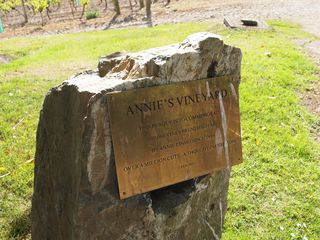
On to quality. The quality philosophy at Camel Valley is as amazingly simple as it is wise and effective: just do more of what works and less of what doesn't. So no bunch thinning as they have found that it does not reduce the crop produced by the vines but just increases the size of the remaining berries. Maximising concentration is not the point of winemaking here anyway. They do employ cold settling and ferment at 13 - 14 C in stainless steel to maximise flavour and aroma. They firmly believe that the Bacchus grape (a 1933 German cross of (Sylvaner x Riesling) x Müller-Thurgau) has a potential to produce wonderful dry wines that so far it only expresses in England and I must say that I concur. In Germany Bacchus occasionally produces nice sweet wines but the dry ones are usually dire. Not so here! At Camel Valley they have also started to embrace the concept of terroir in recent years (somewhat to Bob's own surprise!) with the launch of the Darnibole Bacchus, named after one of their vineyards which has a subsoil of ancient slate. It is clearly different from the straight Bacchus in that it has more depth and broader shoulders too. The only drawback: only 3,000 bottles were produced in 2009 and 6,000 in 2010. There is some 2010 left at the winery and as I have secured my allocation please feel free to get it before it sells out!
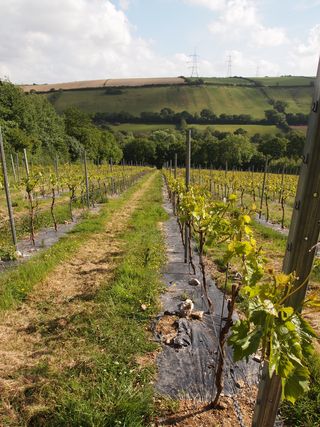 Darnibole vineyard
Darnibole vineyard
Finally marketing. From the word go, Camel Valley have been able to sell their wines well. Again the philosophy is remarkably simple and effective: make the best wine you can, win prizes and tell people about it! It involves making wines that are both distinctive and attractive. So no point in trying to make champagne in Cornwall; almost half a billion bottles of champagne are produced annually in France and that serves the population of the planet admirably. Better to make truly English sparkling wine like the Cornwall Brut from Seyval Blanc and Reichensteiner with its lovely notes of elderflower or the Pinot Noir Brut Rosé (de saignée) with its delicate sweet fruit of strawberry and raspberry (particularly noticeable in the delicious current 2009 vintage). Imitation may be the sincerest form of flattery but the people at Camel Valley put authenticity above all else.
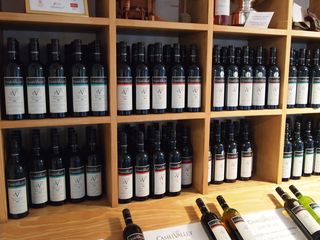
These days it's Sam Lindo making the wine at "Lindo père et fils" and a magnificent job he does too. The number of awards is ever increasing, with those for the Pinot Noir Brut Rosé 2008 the epitome of achievement so far; best sparkling rosé in the world at the International Wine Challenge 2010 and ditto at the Boloncini del Mondo 2010. Camel Valley Wines clearly continues to go from strength to strength and Bob Lindo is obviously very happy to have passed the reigns to the next generation and (merely) to serve as a sounding board for his talented son. It would be merely pretentious and superfluous to predict a bright future...
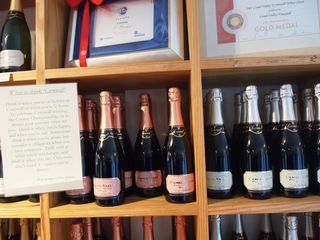
Demand for these wines far outstrips supply and Camel Valley wines feature on the wine lists of many Michelin starred restaurants in Cornwall and throughout the UK. Berry Bros, Fortnum & Mason and Waitrose are all clamouring for more bottles. Fortunately however not everything is pre-sold and bottles are kept back for sale at the winery so that you and I can enjoy the privilege of actually drinking them too! For those who can't get enough I will conclude this post with some brief tasting notes (25 May 2011):
Atlantic Dry 2010
A blend of undisclosed composition. Discreetly fragrant, not very pronounced but subtle rather, nice complexity, smooth texture; a light, clean, zippy and versatile wine with good length.
Bacchus Dry 2010
Very pure and aromatic, "bien typé" as they say in France, lovely acidity and minerally grip, spicy complexity, good length. A wine with oomph and a worthy successor to the wonderful 2009. Will benefit from another six to twelve months in bottle.
Bacchus Dry Darnibole 2010
Clearly has more depth and intensity than the previous wine and broader shoulders too. Altogether a more serious wine that remains playful at the same time, with slatey minerality and well-integrated acidity giving it lift and length.
Rosé 2009
Two-thirds Pinot Noir and one third Dornfelder. Lovely strawberry fruit, elegant and well-balanced, with the Dornfelder adding some extra colour and weight.
Red 2009
Rondo, Triomphe, Dornfelder and Pinot Noir. Good colour, spicy nose with good fruit, a bit light on the mid-palate, nice aromatic length. Pleasant and very good for what it is.
Brut 2009
A quintessentially English bubbly from Seyval Blanc and Reichensteiner. Fresh, vibrant and fragrant (elderflower!) with delicious fruit; a celebration in a glass. A comparison with champagne is pointless but there are many champagnes to which I would prefer this!
Pinot Noir Brut Rosé 2009
Absolutely delicious fruit of strawberry and raspberry, very much a fruit-driven wine, wonderfully refreshing and stylish, balanced and elegant, dry but well rounded out. "Un grand charmeur".
White Pinot Brut 2006
A late release (after the already sold-out 2007). This time they did wait for autolysis to provide a creamy, biscuity character and it was worth the wait. A lovely and classically styled Blanc de Noirs whose flavours will be amplified by further post-disgorgement ageing.
Xavier Auerbach












